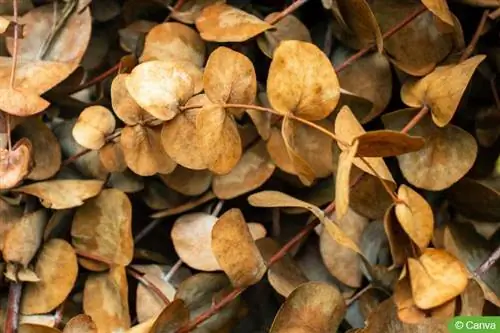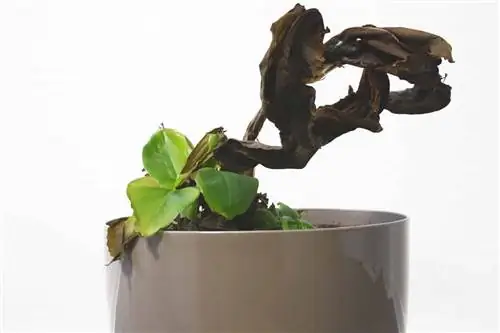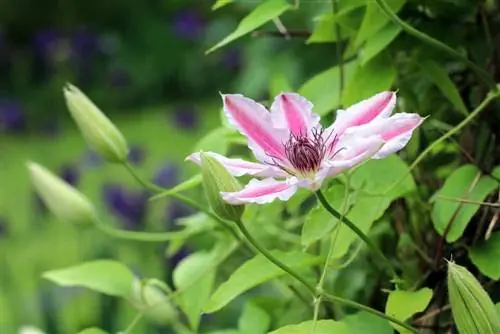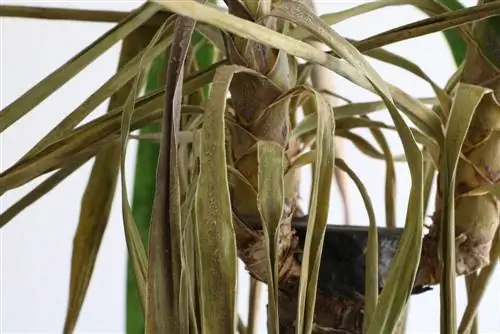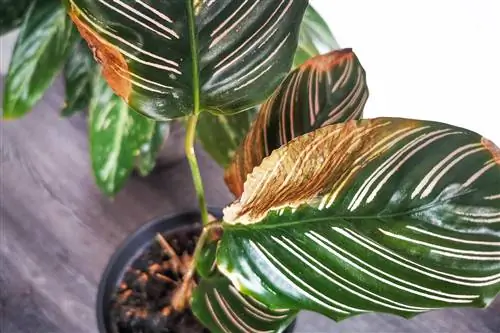- Author admin [email protected].
- Public 2023-12-17 03:39.
- Last modified 2025-01-24 12:45.
The eucalyptus is becoming more and more a trend plant. With its blue-green leaves, the eucalyptus sets beautiful accents. However, sometimes the leaves can become discolored. Everything about the causes and relief measures below.
Causes of leaf discoloration
Usually the eucalyptus is extremely robust. However, yellow or brown leaves can sometimes appear. Various care errors are primarily responsible for this. Causes can be
- wrong location
- Waterlogging
- prolonged dryness
- no nutrients
- vessels too small
- Pest infestation such as mealybugs or mealybugs
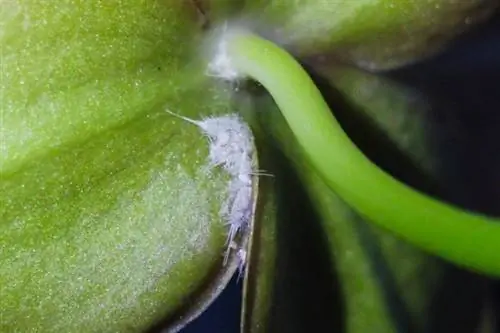
Note:
If white dots are visible when the leaves turn yellow, this is an infestation of mealybugs or mealybugs.
Rapid relief measures
Normally, leaf discoloration that occurs from time to time and subsequent leaf fall is not a cause for concern, as older leaves are replaced by new ones. However, if brown and yellow leaves or white spots appear on the leaves, you must act quickly. Beforehand, it is necessary to identify the cause of the discoloration of the foliage. Below you will find some tips and measures to keep your eucalyptus he althy.
Choose the right location
The location and substrate are important for he althy growth. The eucalyptus loves
- a sunny, bright, warm location
- several hours of direct sunlight daily
- a stay outdoors from May to October
- fresh humus-rich and nutrient-poor soil
- prefers loamy-sandy substrate
- acidic pH between 5 and 6
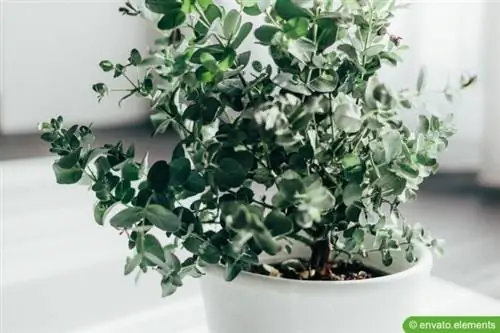
Note:
The eucalyptus can also be placed in partial shade, but here it grows more slowly and its beautiful blue-silvery leaf color is largely absent.
Be careful when watering
Prolonged drought can quickly lead to yellow and ultimately dried leaves on eucalyptus. During the growing season, eucalyptus needs plenty of water. But be careful, the tree reacts to waterlogging by dropping leaves:
- water abundantly and thoroughly
- daily in hot summers
- Avoid waterlogging
- add a drainage layer made of expanded clay or pebbles in the pot
- Use of low-lime water, preferably rainwater
- water less in winter, once a week
- Root ball must not dry out
Tip:
If the leaves of the eucalyptus fall off due to incorrect watering, a radical cut may be able to save the plant.
Dosing the nutrient dose correctly
The nutrient requirements of eucalyptus are not very high. Fertilizer doses should therefore be kept low. Too high doses, or none at all, can lead to leaf discoloration and ultimately leaf fall. When fertilizing you should therefore note the following:
- from spring to summer once a week
- fertilize every 14 days in winter if the location is warm
- Use of liquid fertilizer such as olive and eucalyptus fertilizer
- alternative use of slow-release fertilizer

Roots need space
The eucalyptus is very fast growing. The roots therefore need space. In a container that is too small, the tree can hardly absorb water and nutrients, which ultimately leads to the leaves dying. Repotting should be done annually:
- choose a sufficiently large pot
- best time in March after the winter rest
- Do not damage roots
Beware of lice
Although pests are usually repelled by the essential oils contained in the leaves, an infestation can sometimes occur in the winter quarters. Leaves that have white spots are the first signs of an infestation with mealybugs and mealybugs. To avoid further damage, they must be combated as quickly as possible:
- Isolating plants
- Make a mixture of 1 liter of water, 15 ml each of paraffin oil and spirit
- Use lubricating or curd soap as an alternative to paraffin oil
- Spray plant
- repeat every two days
- Remove heavily infested plant parts and dispose of them in the trash
- Winter quarters should be ventilated regularly and well
Frequently asked questions
Up to how many degrees is the eucalyptus hardy?
The eucalyptus is not completely hardy. In this country, the tree can only spend the winter outdoors with suitable protection in favorable climatic regions, such as wine-growing regions. Otherwise, frost-free and bright wintering at 5 to 10 degrees is required. In dark locations the plant loses its leaves. In mid-May, when frost is no longer expected, the eucalyptus can be moved outdoors again. Clearing out should then be done on an overcast day.
What should you pay attention to when pruning?
As a rule, the tree is extremely tolerant of pruning. The best time to prune is after wintering. The eucalyptus is cut by a third. New shoots then form in the leaf axils. Furthermore, all dead and diseased shoots are removed. Shoots that grow crosswise should be shortened significantly. The interfaces on thicker branches must be treated with a wound protection product. A radical cut is also well tolerated. After a few months the eucalyptus sprouts again.
Is it possible to propagate eucalyptus by cuttings?
Yes. To do this, ten centimeter long cuttings are cut in late spring or June/July. All the lowest leaves are removed. The shoot is then dipped in hormone powder and placed in a pot with potting soil. The pot must be kept bright, warm and moist. The first roots will form under a transparent cover after about four weeks. Alternatively, the cutting can also be rooted in a glass with water.

